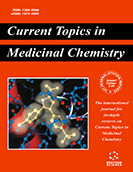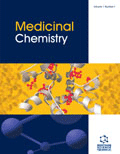摘要
背景:伴随CD4 + T辅助细胞分化的动态表观遗传改变已涉及多种自身免疫疾病。溴结构域和末端外(BET)蛋白是表观遗传调节因子,其识别并结合染色质中的乙酰化组蛋白并且是药理学抑制的靶标。在这项研究中,我们在临床开发中测试了一种新的BET抑制剂OTX015,以询问其对与自身免疫相关的关键CD4 + T细胞亚群的影响。 方法:分离幼稚和记忆鼠及人CD4 + T细胞,并分化为以干扰素(IFN)-γ和白细胞介素(IL)-17表达为特征的群体。然后将培养的细胞在体外暴露于不同浓度的OTX015,并通过流式细胞术定量其对细胞因子表达的影响。平行地,通过PCR定量转录因子TBX21和RORC的表达。先前研究的BET抑制剂JQ1用作药理学对照。 结果:OTX015抑制了鼠和人CD4 + T细胞的增殖。它对细胞因子表达的影响在鼠和人的幼稚和记忆亚群中有所不同。 OTX015在抑制细胞因子和T辅助细胞增殖方面与JQ1相似。较高浓度的OTX015对小鼠与人细胞的存活率也有较大影响。 IL-17和IFN-γ表达在鼠记忆CD4 + T细胞中没有改变,而在人记忆CD4 + T细胞中,OTX015抑制IL-17,但不抑制IFN-γ。在所有人T细胞亚群中,OTX015比IFN-γ更有效地抑制IL-17。 结论:我们的研究表明OTX015具有抗炎作用,通过抑制鼠和人CD4 + T细胞增殖和亚群依赖性促炎细胞因子的表达,包括选择性抑制人类记忆CD4 + T细胞中的IL-17。
关键词: 自身免疫性疾病,CD4 + T细胞,OTX015,溴结构域和末端结构域(BET)抑制剂,表观遗传学,免疫抑制,抗增殖。
Current Molecular Medicine
Title:The Bromodomain and Extra-Terminal Protein Inhibitor OTX015 Suppresses T Helper Cell Proliferation and Differentiation
Volume: 18 Issue: 9
关键词: 自身免疫性疾病,CD4 + T细胞,OTX015,溴结构域和末端结构域(BET)抑制剂,表观遗传学,免疫抑制,抗增殖。
摘要: Background: Dynamic epigenetic alterations accompanying CD4+ T helper cell differentiation have been implicated in multiple autoimmune diseases. The bromodomain and extra-terminal (BET) proteins are epigenetic regulators that recognize and bind to acetylated histones in chromatin and are targets for pharmacological inhibition. In this study we tested a new BET inhibitor under clinical development, OTX015, to interrogate its effects on key CD4+ T cell subsets associated with autoimmunity.
Methods: Naïve and memory murine and human CD4+ T cells were isolated and differentiated into populations characterized by the expression of interferon (IFN)-γ and interleukin (IL)-17. Cultured cells were then exposed to varying concentrations of OTX015 in vitro, and its impact on cytokine expression was quantified by flow cytometry. In parallel, the expression of the transcription factors TBX21 and RORC was quantified by PCR. A previously studied BET inhibitor JQ1 was used as a pharmacological control.
Results: OTX015 suppressed both murine and human CD4+ T cell proliferation. Its impact on cytokine expression varied in murine and human naïve and memory subsets. OTX015 was similarly effective as JQ1 in the suppression of cytokines and T helper cell proliferation. Higher concentrations of OTX015 also had a greater impact on the viability of murine versus human cells. IL-17 and IFN-γ expression was not altered in murine memory CD4+ T cells, whereas in human memory CD4+ T cells, OTX015 inhibited IL-17, but not IFN-γ. Across all human T cell subsets OTX015 suppressed IL-17 more effectively than IFN-γ.
Conclusion: Our studies demonstrate that OTX015 has anti-inflammatory effects by suppressing murine and human CD4+ T cell proliferation and subset-dependent proinflammatory cytokine expression, including the selective suppression of IL-17 in human memory CD4+ T cells.
Export Options
About this article
Cite this article as:
The Bromodomain and Extra-Terminal Protein Inhibitor OTX015 Suppresses T Helper Cell Proliferation and Differentiation, Current Molecular Medicine 2018; 18 (9) . https://dx.doi.org/10.2174/1566524019666190126112238
| DOI https://dx.doi.org/10.2174/1566524019666190126112238 |
Print ISSN 1566-5240 |
| Publisher Name Bentham Science Publisher |
Online ISSN 1875-5666 |
 43
43 8
8 1
1
- Author Guidelines
- Bentham Author Support Services (BASS)
- Graphical Abstracts
- Fabricating and Stating False Information
- Research Misconduct
- Post Publication Discussions and Corrections
- Publishing Ethics and Rectitude
- Increase Visibility of Your Article
- Archiving Policies
- Peer Review Workflow
- Order Your Article Before Print
- Promote Your Article
- Manuscript Transfer Facility
- Editorial Policies
- Allegations from Whistleblowers
Related Articles
-
Pharmacokinetics of Biotech Drugs: Peptides, Proteins and Monoclonal Antibodies
Current Drug Metabolism The Yin and Yang of Non-Neuronal α7-Nicotinic Receptors in Inflammation and Autoimmunity
Current Drug Targets A Review of the English and Russian Language Literature on the Osteoarticular Manifestations of Brucellosis Infection
Current Rheumatology Reviews Hepatocellular Carcinoma in Alcoholic Liver Disease: Current Management and Recent Advances
Reviews on Recent Clinical Trials Oxidative Stress and Post-Stroke Depression: Possible Therapeutic Role of Polyphenols?
Current Medicinal Chemistry PASylation as a Powerful Technology for Improving the Pharmacokinetic Properties of Biopharmaceuticals
Current Drug Delivery The Forkhead Transcription Factor FOXO3a Controls Microglial Inflammatory Activation and Eventual Apoptotic Injury through Caspase 3
Current Neurovascular Research n-3 Polyunsaturated Fatty Acids and the Prevention of Colorectal Cancer: Molecular Mechanisms Involved
Current Medicinal Chemistry Dine (Damage-Induced Neuronal Endopeptidase)
Protein & Peptide Letters Immobilization-Induced Behavioral Deficits are Attenuated But Coping with Repeated Stress Impaired in Apomorphine Injected Rats
Current Psychopharmacology Lipid Membrane; A Novel Target for Viral and Bacterial Pathogens
Current Drug Targets Current and Future Applications of Probiotics
Current Nutrition & Food Science Wound Repair - Updates in Dressing Patents and Regeneration Biomarkers
Recent Patents on Biomarkers TRAIL as Biomarker and Potential Therapeutic Tool for Cardiovascular Diseases
Current Drug Targets Immunotherapy of HCC
Reviews on Recent Clinical Trials Preface
Current Pharmaceutical Design Pharmacophore Modelling as a Virtual Screening Tool for the Discovery of Small Molecule Protein-protein Interaction Inhibitors
Current Pharmaceutical Design Targeting Kit Activation: A Potential Therapeutic Approach in the Treatment of Allergic Inflammation
Inflammation & Allergy - Drug Targets (Discontinued) The Roles of the PDZ-containing Proteins Bridge-1 and PDZD2 in the Regulation of Insulin Production and Pancreatic Beta-Cell Mass
Current Protein & Peptide Science Cancer Therapy Based on a Mechanism of Action for Controlling the Immune System and the Resulting Patent Portfolio
Recent Patents on Endocrine, Metabolic & Immune Drug Discovery (Discontinued)

















.jpeg)








